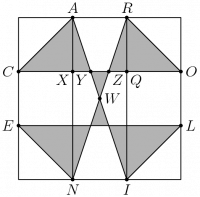2018 AIME II Problems/Problem 4
Contents
Problem
In equiangular octagon ![]() ,
, ![]()
![]() and
and ![]() . The self-intersecting octagon
. The self-intersecting octagon ![]() encloses six non-overlapping triangular regions. Let
encloses six non-overlapping triangular regions. Let ![]() be the area enclosed by
be the area enclosed by ![]() , that is, the total area of the six triangular regions. Then
, that is, the total area of the six triangular regions. Then ![]()
![]() , where
, where ![]() and
and ![]() are relatively prime positive integers. Find
are relatively prime positive integers. Find ![]() .
.
Solution
We can draw ![]() and introduce some points.
and introduce some points.
The diagram is essentially a 3x3 grid where each of the 9 squares making up the grid have a side length of 1.
In order to find the area of ![]() , we need to find 4 times the area of
, we need to find 4 times the area of ![]()
![]() and 2 times the area of
and 2 times the area of ![]()
![]() .
.
Using similar triangles ![]()
![]() and
and ![]()
![]() (We look at their heights),
(We look at their heights), ![]()
![]()
![]() . Therefore, the area of
. Therefore, the area of ![]()
![]() is
is ![]()
![]()
![]()
Since ![]()
![]()
![]() and
and ![]() ,
, ![]()
![]()
![]() and
and ![]()
![]()
![]() .
.
Therefore, the area of ![]()
![]() is
is ![]()
![]()
![]()
![]()
![]()
![]()
Our final answer is ![]()
![]()
![]()
![]()
![]()
![]()
![]()
![]()
![]()
![]()
![]()
Solution 2
![]() is essentially a plus sign with side length 1 with a few diagonals, which motivates us to coordinate bash. We let
is essentially a plus sign with side length 1 with a few diagonals, which motivates us to coordinate bash. We let ![]() and
and ![]() . To find
. To find ![]() 's self intersections, we take
's self intersections, we take
![]()
And plug them in to get ![]() where
where ![]() is the intersection of
is the intersection of ![]() and
and ![]() , and
, and ![]() is the intersection of
is the intersection of ![]() and
and ![]() .
.
We also track the intersection of ![]() and
and ![]() to get
to get ![]() .
.
By vertical symmetry, the other 2 points of intersection should have the same x-coordinates. We can then proceed with Solution 1 to calculate the area of the triangle (compare the ![]() -coordinates of
-coordinates of ![]() and
and ![]() and
and ![]() ).
).
See Also
| 2018 AIME II (Problems • Answer Key • Resources) | ||
| Preceded by Problem 3 |
Followed by Problem 5 | |
| 1 • 2 • 3 • 4 • 5 • 6 • 7 • 8 • 9 • 10 • 11 • 12 • 13 • 14 • 15 | ||
| All AIME Problems and Solutions | ||
The problems on this page are copyrighted by the Mathematical Association of America's American Mathematics Competitions. 










